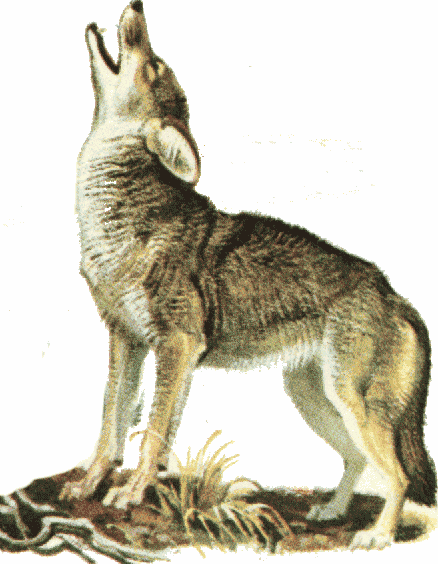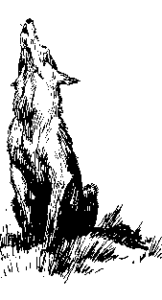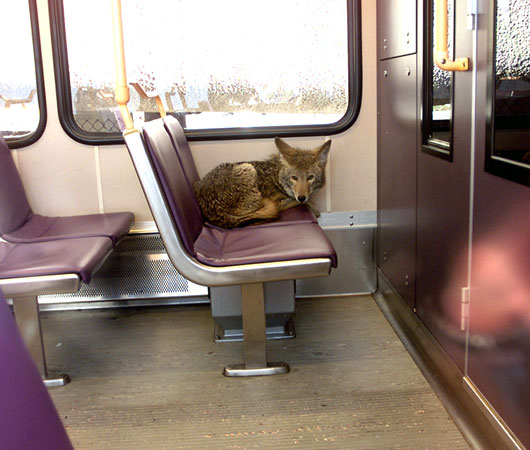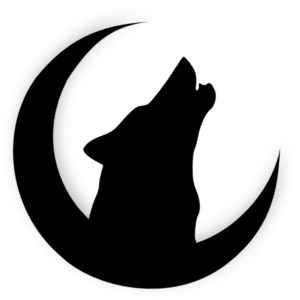And Still the Song Dog Sings

IT IS GOOD to hear the coyotes singing again. For a few weeks last month we were awakened now and then to their yips and wails coming from someplace across the canal where they’d been prepping for this season’s litter of pups. We hadn’t expected to hear from them this year because of the big yellow machines that have lately come and leveled the forest that once grew over there, and scraped the surrounding fields to rows of rubble and naked flats of glaring sand. But still the coyotes are out there, somewhere in the cracks and crawlspaces of the greenspace that used to be. And in those quiet hours before our daily bombardments of heavy machinery, those tenacious little beasts, bless their hearts, are singing.
But that which is coyote music to some, is to others the baying of hounds from hell. There are those who are imagining predatorial gangs roaming the streets, eyeing their little dogs and loose cats, looking to pluck their kids off the playground. And so after every new nightly serenade, we can expect by morning a certain frantic refrain on the neighborhood chatrooms:
‘Watch your pets! The coyotes are on the hunt!’
‘They must have made a kill. Does somebody have a number for Animal Control?’
What the coyotes are actually saying has nothing to do with pumping themselves up for the hunt, nor with celebrating fresh blood. They’re simply checking in with family: ‘I’m here. Where are you?’ Or maybe they’re voicing a warning to an intruding coyote: “This territory is taken, keep your distance.” The coyote’s song is not one of killing or conquest, but of greetings. At its most sinister it is a vocal plea for avoiding physical conflict. Ultimately its theme is one of peace.
Yet for some those falsetto wails still evoke the banshee cries of Mongol hordes descending. And they respond in misguided kind with barbaric savagery. For over a century we’ve been laying waste to America’s song dog, mainly on bogus charges of its existential threat to the sheep industry. (Which has actually been foundering for a range of far less dramatic reasons, from the price of hay to the sheepmen’s age.) The scapegoated coyote has suffered a relentless assault by a U.S. army of predator killers who’ve been mining the countryside with traps and snares, gassing dens full of pups, and raining poisons and bullets from the skies. It’s a government-sanctioned offensive that continues to this day, with those tax-funded troops still operating under the Orwellian title of Wildlife Services.
And for a certain private sect of American culture, coyote killing has become a wholesome social affair. Weekend warriors are out there in camouflage coveralls and ATV’s, blasting coyotes for fun and prizes, and trashing their carcasses in big bloody heaps. Did you know there’s a sport called whacking—in which you run a fleeing coyote to exhaustion in deep snow, then crush it with your snowmobile? Figuring the casualties from all fronts, the body count is now estimated at half a million slain coyotes a year.

AND STILL THE song dog sings. Since the blitzkrieg began, the uncanny coyote has astonishingly flourished. They have done so in part by filling the ecological void left by its larger competitor, the wolf, who was driven by those same anti-predator armies from all but a northern sliver of the Lower 48. The coyote has also prospered through its inherent genius for adaptability. What the coyote’s students have been explaining for decades, but its haters have refused to hear, is that the coyote comes with a reproductive engine that accelerates as the killing ramps up—that coyotes from broken families tend to breed younger and produce more pups.
Over the past century of siege the coyote has thus gone from a prairie and plains animal to a cosmopolitan resident of North America, from Alaskan tundra to New England woodland, Baja desert to Florida scrub, from the streets of San Francisco to Manhattan’s Central Park. There are coyotes now sniffing about the banks of the Panama Canal, poised to colonize South America. There are coyotes denning within howling distance of the White House. It is this dogged display of resilience in the face of our ugliest, most adolescent aggressions that now brings a certain hope, for those most in need of it.
Joanna Lambert is a behavioral ecologist at the University of Colorado in Boulder, who when not teaching in the shiny postcard city with the Rocky Mountain backdrop, has been observing primates in the equatorial jungles of Uganda. Rather, that is, she has been observing their demise. For thirty years Lambert has paid witness to a malignant decay eating through the wildlands of sub-Saharan Africa. Year after year she has returned to see her subjects driven asunder before a hungry human population tripling under her watch. It’s a trauma that has worn heavily on Lambert’s psyche.
“Each time I came back from the field season I had this weight,” she says. “Depressed. Unable to work. For a long time, I didn’t know what it was.”
What it was, Lambert discovered, was a psychological malaise found to be rather common among her fellow conservation scientists and practitioners. Its victims are those who know too well the pain of watching, day by dispiriting day, the assault on the wild places and creatures they have come to see as home and family. “I realized,” said Lambert, “this ecological grief is a thing.”
It was a thing that in Lambert’s world of wounds came with no ready prescription or therapy. Until she stopped to consider the coyote. Just half an hour down the road from Boulder, in metropolitan Denver—and for that matter in every major U.S. city—was a thriving population of them. Here was this scrawny, scrappy little predator who had trotted into the heart of the enemy camp and made home of it. Here, finally, was this wild soul that the human juggernaut could not crush.
“For me,” says Lambert, “trying to imbue my work with hope became a conscious thing. I started thinking of winners and losers in this human-dominated age we call the Anthropocene. That’s why I started studying coyotes.”
Lambert and her grad students have since joined a raft of researchers now watching the coyotes of urban America, variously spying with radio collars and body cams, and sifting through their scat. They find the city coyotes hunting their customary rabbits and rodents, but also chasing untended housecats and raiding gardens and garbage bins. More and more we common folk see them too, sauntering past us on the sidewalks, denning beneath our porches, crossing busy streets like veteran jaywalkers. In 2002, one particularly enterprising coyote famously boarded the commuter train from Portland International Airport and took a seat.

Next stop, City Center. A coyote gets comfy on Portland’s MAX light rail commuter train
Such astonishingly swift adaptations to city life are what draw Lambert’s particular attentions. City coyotes are growing bolder by the year, more comfortable with life among us. Coyote parents are teaching this boldness to their pups, who in turn are teaching it to their own. And perhaps, if Lambert’s suspicions hold true, they are even passing it along in their genes—a rapid feat of natural selection that challenges the tenets of slow, gradual, Darwinian evolution. By hitching its evolutionary wagon to ours, the coyote would appear to be reinventing itself, in a fashion eerily reminiscent to that milestone in life’s history some thirty thousand years ago, when wolves domesticated themselves into dogs.
By whatever the means, the coyote is forcing humanity to reconsider our humbler, more tolerant selves, the kind who once shared this world with a bestiary far more ferocious than today’s. It’s a certain humility we’ve otherwise forgotten during our ten-thousand-year sprint from scattered bands of Pleistocene hunter-gatherers walking among mega-carnivores, to the swarming, all-consuming masses of the Anthropocene now driving the last of those beasts to oblivion.
The coyote has turned the tables. And right behind it are a few fellow predators taking their own first steps in that direction. Lambert notes the golden jackal, Eurasia’s analog to the coyote, expanding its range from the moors of Denmark to the slopes of the Himalayas. She mentions with hope the recent news of wolves denning in Rome, leopards living in Mumbai, mountain lions in Los Angeles.
“We need these success stories,” she says, “because, yes, we have lost a lot, and we all feel the emotional burden of that. But there are successes.”

IT IS ON these precious scraps of encouragement that we mourners of the wild find sustenance. We are in essence emulating the indomitable coyote, making the best of a world bent on obliterating our native home.
Seventy-five years ago the western historian and coyote biographer, J. Frank Dobie wrote, “If I could, I would go to bed every night with coyote voices in my ears and with them greet the gray light of every dawn. When I remember their derision of campfires, their salutes to the rising moon, their kinship cries to stars and silences, I am ten thousand times more grateful to them than I am to the makers of the blaring radios and ringing telephones that index the high standard of American living.”
And still the song dog sings, in defiance of a world overrun by those who are deaf to the music. Even now, half an hour before dawn, I see those big machines rolling in, their headlights creeping this way. I hear their dozer tracks clattering, their mighty diesels growling. I feel them shaking the walls of my study, getting an early start on their inexorable ungreening of Florida.
Yet there will come the hour when even they must sleep. And with the next moon I’ll listen again for that song of the wild that laughs at their insults and forever sings of hope.
###
For more on those amazing coyotes among us, here’s a sampling of websites and readings:
Research Hubs
Books
The Voice of the Coyote, J. Frank Dobie, 1947.
Coyote America, Dan Flores, 2016.
Video
Fear, Wild Things, and Coexisting with Predators—an inspiring hour with Joanna Lambert, hosted by Project Coyote and the Rewilding Institute.
Wildlife Killing Contests—viewer discretion advised…
…but for something to lighten your heart, check out this musical homage from Modest Mouse, inspired by the train-hopping coyote of Portland.
I had the pleasure of hearing Don Flores (Coyote America) speak at the Elko National Cowboy Poetry Gathering few years back – presented by the local college. It was fascinating to learn the “Wiley” Coyotes ability to adapt to all the horrors thrown at them especially by our government. Have his book it’s a fascinating read. In my north Bay Area community in the foothills the coyote is forever presence with his song and travels about the oak woodlands. It’s interesting to read the absurd comments an NextDoor to which I counter with reason and respect and hopefully dispel the myths and encourage tribute to this intrepid species.
Amen, Rosemary. The song dog needs all the voices he and she can get. I too tend to chime in on the NextDoor disinformation, with praise for the underdog. I’m happy to say, I’m usually not alone in coming to their defense. We’ll get there someday.
Resonate, definitely. I heard my first chorus of the singing dogs back in the mid 80’s when I was camping in the Tonto National Forest north of Phoenix. As I slowly awoken after a restful sleep in my tent, I thought I heard babies (human) crying. It startled me initially as I was a bit drowsy still but it wasn’t until my husband (now deceased) told me they were coyotes that I came to love their songs. A decade later I moved to rural Nebraska and I slowly came to realize they were considered vermin by many farmers and ranchers. My neighbor one day said she saw a pickup truck full of their dead coyotes (which broke her heart) driving through town. I was baffled by the cruelty. But now, living in Tucson (and back in my lovely coyote state of AZ) I see and hear them when I am walking in the neighborhood. I feel like they and I have come full circle. Thank you for heartfelt and heartbreaking words and for your love of the singing dogs. There is poetry and music in their genes.
Thanks Linda, for singing your praises of the song dogs.
I would recommend adding a title to your Coyote book list: Don Coyote: The Good and Bad Times of a Maligned American Original by Dayton O. Hyde.
Dayton became more famous in his later years for developing the Black Hills Wild Horse Sanctuary, an 11,000 acre reserve for unwanted American Mustangs in S. Dakota, but was previously a Cowboy, Rodeo Clown, and most importantly a wildlife friendly ranch owner (yes, they do exist!) in Southern Oregon. He supported and wrote about wildlife through his long and storied life (recently died at age 93,) and that book gave me a deeper appreciation of the merits of the “singing dog”. Highly recommended!
More about Dayton: “Dayton believed he was a cowboy first, conservationist second and writer third. As a kid, he had always wanted to ride a horse and he never turned down an adventure.” Sounds like my kind of guy! And probably yours too, Will.
https://www.wildmustangs.com/dayton-o-hyde
Thanks Keith. Wish the man was still alive. I’d make it a point to go meet him.
Thanks for shedding light on these resilient canines, Will… I’ve been fascinated by these beautiful bubbas, since reading “The Daily Coyote,” by Shreve Stockton… Your words tug at our heartstrings, just as the singing from each song dog does…
It’s so encouraging to hear they resonate with so many. And just as I was reading your note, I opened my window to hear them singing across the way. So blessed.